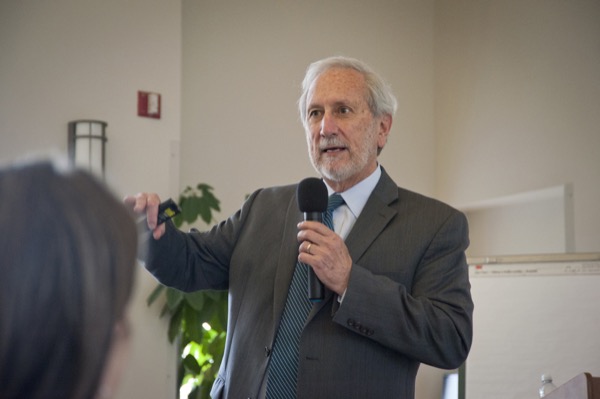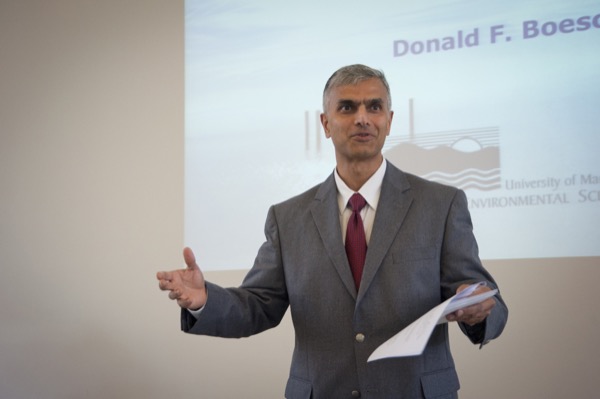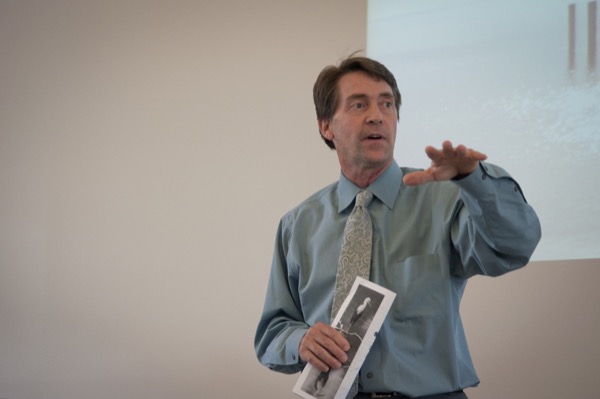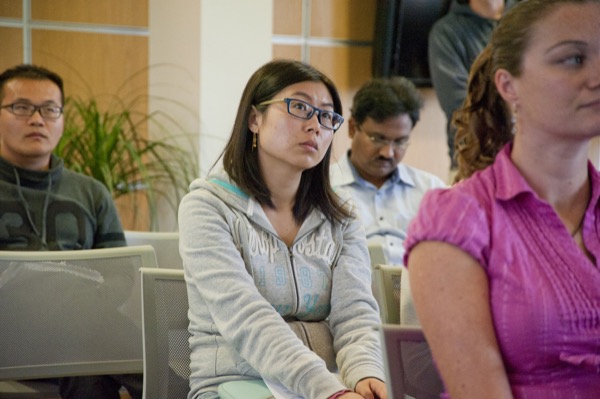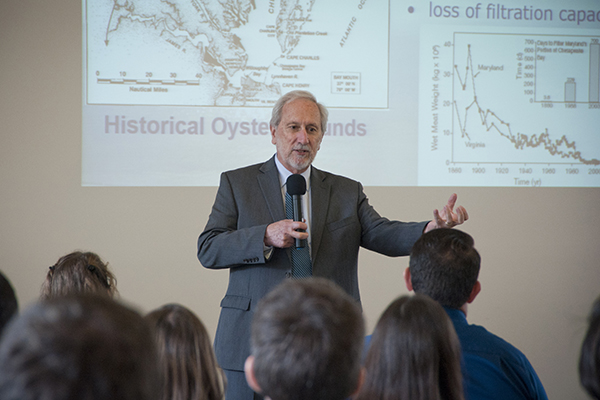Water symposium
Second annual UD water symposium focuses on science, policy
1:15 p.m., Oct. 2, 2015--University of Delaware students and faculty, as well as professionals from industry, government and non-profit organizations, gathered in the Townsend Hall Commons on Friday, Sept. 25, as part of the second annual Water Science and Policy Symposium.
Donald Boesch, professor of marine science and president of the University of Maryland Center for Environmental Science, served as the plenary speaker for the event and addressed his experiences with a talk titled “Science and Policy in the Chesapeake Bay: The Long-Haul and the Tight Crunch.”
Research Stories
Chronic wounds
Prof. Heck's legacy
Boesch discussed the physical characteristics of the bay and how those characteristics that define its vulnerability — such as shallow waters, unique shoreline dimensions and a drainage catchment that includes six states — are also what make it such a productive ecosystem.
Boesch said that when studying the Chesapeake, it is important to understand the bay beyond its geological history. “Humans have always had some impact on the Chesapeake Bay, even the small populations of Native Americans in terms of local resources, but it really started to grow substantially with the advent of the migration of the large number of Europeans into North America,” he said.
This impact was mainly through deforestation.
“When they used the landscape to grow tobacco and other crops, they were making it change from being a clear water, nutrient limited system that is still highly productive to one that is now turbid and eutrophic, which has more nutrients, one that is highly productive but doesn’t necessarily lead to the same kinds of outcomes in terms of higher trophic levels,” said Boesch.
Boesch pointed out some of the scientific pioneers who have studied the Chesapeake Bay, including L. Eugene Cronin, who conducted research on the blue crab beginning in the 1950s; Bill Hargis, who was the director of the Virginia Institute of Marine Science from its founding in 1959 until 1981; and Don Pritchard, who studied the bay for 50 years and discovered that it contains two layers of water — lighter fresh water on top and salty water along the bottom.
He also pointed out statistics, such as how the oyster population of the bay is less than one percent of historic levels due to loss of habitat and filtration capacity.
Boesch said that industrial agriculture as part of the Green Revolution had an impact on the Chesapeake, as did Hurricane Agnes in 1972, which he said was like a “big flush” that brought drought-like conditions to the area.
He also said that in recent years, models have been used to estimate how much phosphorous and nitrogen is entering the bay but that the models must confront reality and that it is essential to bring together models and observations to make an adaptive management cycle to help the body of water.
Boesch stressed that when working on science with regard to the Chesapeake Bay, it is important to remember that people’s economic livelihoods are tied to it, which may make them hesitate to adopt environmental friendly practices such as restricting the number of oysters they are able to harvest. It also is important to be able to communicate complicated research to policy makers who may not be familiar with the research.
Boesch ended his talk by giving examples of how science and policies — specifically those aimed at reducing nitrogen and phosphorous inputs — has helped to improve portions of the Chesapeake.
“There are some pretty good success stories about science in the bay that were made through a sustainable use of resources. Striped bass were really in a bad situation and now a lot of those populations have recovered,” he said. “They are doing the same thing in managing blue crab in parts — if you see that it’s a female, you don’t want to catch one because they have a lot of eggs ready to go — and we have massive oyster restoration, trying to rebuild sea populations rather than just put oysters back in.”
Boesch ended by talking about how climate change and sea-level rise will play a role in all environmental science fields now and into the future, and pointed to the Maryland and Delaware Climate Change Education Assessment and Research (MADE-CLEAR) as an example of a program working to engage climate scientists, science educators and the broader community of interest in implementing a comprehensive climate change education plan in the region.
The conference was opened by Shreeram Inamdar, professor in the Department of Plant and Soil Sciences in UD’s College of Agriculture and Natural Resources (CANR) and director of the water science and policy graduate program who organized the symposium, who welcomed the participants and talked about the interdisciplinary nature of the event.
“Since the water graduate program is spread across the University, there are students here from many colleges and departments. I think the symposium is important because it provides the opportunity for these students to connect with each other, see what others are working on, and also connect with water science faculty,” said Inamdar. “Most importantly, however, I want these students to connect with working professionals, and we have some great guests on hand to speak with the students about their professions.”
CANR Dean Mark Rieger spoke about how the symposium is growing and how it was significant to see students sitting along professionals from industry and government.
“It is important to have science-based research to determine what we do with regard to water quality, and it’s great to see the program develop and grow and see the students interact with faculty and industry professionals,” Rieger said.
Rieger added that it is difficult to administer an interdisciplinary effort and praised Inamdar, who he said “has done a great job incorporating four colleges into the program.”
Rieger acknowledged the many UD alumni who were in attendance and taking part in the expert panel discussion. He said this speaks to the importance of building connections and networks at such events.
Research presentations
Following the plenary talk, 15 UD water science and policy students gave five-minute presentations on their research, including topics such as “The Effect of In-Season Fertilization Strategy on the Yield and Nutrient Use Efficiency of Irrigated Corn” and “From Ridge Top to Valley Bottom: Soil Greenhouse Gas Fluxes Across Complex Terrain.”
The presentations were moderated by Alex Soroka, a master’s degree student in CANR, and Matthew Miller, a doctoral student in the college, and student awards were handed out after the presentations.
First place went to Miller for his talk “Extreme Weather and Drinking Water Utilities: Impacts, Risks and Tough Decisions,” second place went to Chelsea Krieg for “After the Storm: Nitrogen Cycling in Flood Sediments and Impacts on Water Quality,” and third place went to Joe Brown for “A Field Study of Biochar Amended Soils.”
A panel discussion followed with panel members including:
- Jennifer Adkins, executive director, Partnership for the Delaware Estuary;
- Christina Casole, water resources engineer, Skelly and Loy Inc.;
- Ed Hallock, program administrator, Office of Drinking Water;
- Alison Kiliszek, engineer, Delaware Department of Natural Resources and Environmental Control (DNREC);
- Christopher Nealen, hydrologist, U.S. Geological Survey;
- Mark Strickland, water resource engineer, Century Engineering Inc.; and
- Larry Trout, senior manager, water resources, RK&K.
The panel was moderated by Sandra Petrakis, a master’s degree student in CANR, and Matthew Miller.
The symposium wrapped up with informal networking and hors d’oeuvres in the Townsend Hall Commons.
Article by Adam Thomas
Photos by Wenbo Fan






